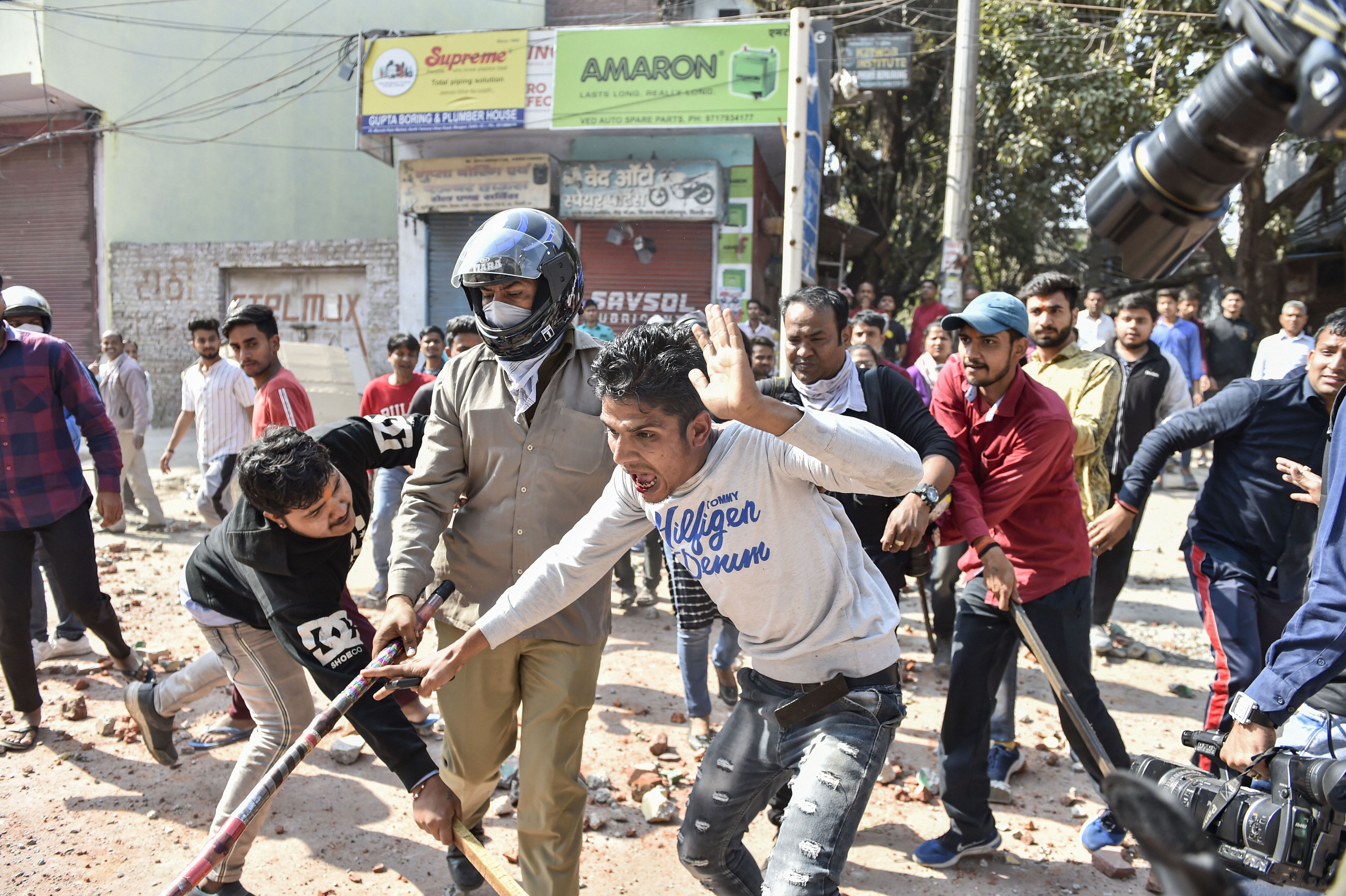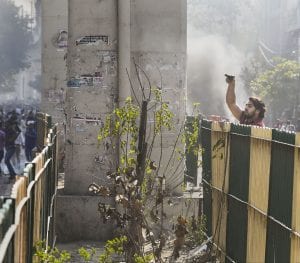
Riotous Delhi soaks in a dirty drain of communal divide
The stink from the drain that cuts across Babarpur and Maujpur is unbearable. An uneasy calm prevails as people peep through windows to see if they can risk venturing out to buy essentials like milk.

The stink from the drain that cuts across Babarpur and Maujpur is unbearable.
An uneasy calm prevails as people peep through windows to see if they can risk venturing out to buy essentials like milk.
Despite heavy deployment of paramilitary forces and the police, there is no semblance of normalcy returning anytime soon — welcome to northeast Delhi’s dustbowl cluster winding through Maujpur Road and leading to the riot epicentres like Gokulpuri, Seelampur, Chand Bagh, and Jaffrabad.
The stinking drain is symbolic of the invisible divide between Hindus and Muslims.
On one side is Maujpur where the population is predominantly Hindu while Muslims live in large numbers in Baburpur, located on the other side, making the drain a Lakshman Rekha that both sides are wary of.
Related news | PM speaks, Doval returns as death toll rises to 27 in Delhi violence
The violence in the past three days have made people on each side see the other as enemy territory. Such is the level of communal chasm in the locality that it overpowers the stink of the drain. Both sides have complained to the police of heavy brick-batting across the drain, and locals say they cannot stay calm when the ‘other side’ was indulging in violence.
The situation in the nearby areas like Karawal Nagar, Brahmpuri, Khajuri Khas, Kardampuri, and Chajjupur is no different.
People of nearby localities blaming each other for violence is common and in most cases the finger points at members of a community that is not theirs.
Roads are deserted as gatherings have been prohibited and people holed up inside their homes want the tensions to end. Nand Gopal, a fruit-vendor living in a slum cluster next to Maujpur, wants to find out if his cart is safe.
At a nearby muddy lane, Rolita is looking for a way to get some ‘atta’ and ‘dal’ to start cooking, but is scared to move out. Many of the residents of North-Delhi’s slum clusters are migrants and they feel it will be safe to return to their native places for the time being, the most worried being the Bangladeshi migrants. Communal hate has done what crime, drugs, illegal firearms and lack of civic amenities can do – leave people scared and worried about their lives. Welcome to the mad scramble of trans-Yamuna ‘jhuggi’ colonies and
unplanned settlements that are home to lakhs of daily-wagers, vendors, rickshaw drivers, electricians, cooks, carpenters, maid-servants, plumbers, drivers, painters,
and people who do odd jobs to make ends meet.
Related news | Brothers, sisters please maintain peace: Modi’s appeal to Delhiites amid riots
These colonies are a source of manpower for the affluent parts of the city like South Delhi and New Delhi, apart from huge markets located at Chandni Chowk, Karol Bagh, Lajpat Nagar, and Sarojini Nagar.
The courier industry, manpower companies providing security guards, and construction firms bank on the lakhs of workers who live in these areas to meet their requirements.
Gun culture in wild east
In the narrow by-lanes of these colonies, law and order is non-existent even on a good day. No wonder, communal wildfire engulfed these areas rapidly, claiming two dozen lives and leaving more than 150 injured while the police were not confident enough to take control of the dark alleys.
Miscreants, unemployed youths, and anti-social elements on both sides were easy puppets for those stoking violence. Social media, forwarded videos, and inflammatory messages also squeezed the triggers and this remains a cause of concern in the age of fake news.

On Tuesday evening (February 25), shops at the Jagatpuri market, that normally remain open till night, were closed in the evening as rumours spread of rioting mobs moving towards the area. Similarly, rumours of sword-brandishing mobs at Kalyanpuri and simmering communal tension at Joshi Colony caused a flutter, before people found out that these were only a figment of imagination.
More worrying is the use of firearms during the riots with doctors at hospitals indicating that more than 50 of the victims had injuries caused by bullets or pellets. While it is already known to the Delhi Police that use of ‘katta’ or country-made revolver is widespread in Delhi localities bordering Ghaziabad, Gautam Budh Nagar in Uttar Pradesh and Gurgaon and Faridabad in Haryana and the February riots have come as a realization to the police that the issue is much bigger.
A senior Delhi police officer said on condition of anonymity that country-made pistols were available for a few thousand rupees and the cost goes up if one opted for better quality. Several consignments of illegal firearms had been confiscated in the recent past and the officer said well-organised networks operated across Uttar Pradesh, Bihar, Rajasthan, Madhya Pradesh and Haryana. Smuggled revolvers made in other countries were also sold in the grey market for a higher price.
Therefore, the shocking image of a youth brandishing a gun at policeman Deepak Dahiya not only highlights that there is no fear of law but also says how illegal firearms are available easily.
Delhi Police officials say constable Ratan Lal, who lost his life in the riots, had suffered bullet injuries. The killing of Ankit Sharma, an intelligence operative under training, and injuries suffered by Amit Sharma, Shadhara’s deputy commissioner of police, also point to how dangerous Delhi’s wild east is.
Enter a Doval
Questions are being asked as to why intelligence wings like the special branch of the Delhi Police failed to gauge the level of communal tension on the ground. Did they forget the Seelampur violence of December? No way, but the Delhi police were being pulled in different directions in the run-up to the northeast Delhi fiasco. First, Police Commissioner Amulya Patnaik has already retired and is on extension till the end of February by virtue of the recent Delhi Assembly Elections.
It is also well known that Delhi Police personnel had virtually revolted against him after the infamous Tees Hazari clash with lawyers in November. While the morale was low, the Shaheen Bagh protests, Jamia clashes and JNU violence also stretched them as they were asked to explain lapses.
That Team Delhi Police was not in the best of spirits was the reason why Prime Minister Narendra Modi and Home Minister Amit Shah had to play their trump card – National Security Advisor Ajit Doval. The Man for All Seasons had to rush from Trump visit engagements to firefighting in northeast Delhi, within a matter of hours. The situation at that juncture was so bad that the former IPS officer and the trusted man of Team Modi rolled his cavalcade to police stations in the riot-hit areas and got the Delhi Police up and running, pushing them to do ‘area domination’ that is key to controlling violence.
Related news | Kejriwal demands army deployment in Delhi as death toll soars to 20
Fresh blood was also infused in terms of additional para-military forces and ‘super-sleuth’ Doval organised more flag marches across affected areas to put the fear of law in the minds of vandals who had a free run for almost 48 hours in certain areas.
He also drove into certain affected areas to signal the return to normalcy and provide the optics to stress the point. If the leadership had realized the gravity of the situation earlier, they may have pressed Doval into service even before Trump arrived in the capital.
Assembly-line provocation
While the intensity of the violence and the death toll are shocking, the provocation and communal build-up was so unabashed during the Delhi Assembly election campaign that its nasty impact now looks so obvious. From Anurag Thakur to Kapil Mishra and Parvesh Mishra to Yogi Adityanath, provocation was there for all to see. That Shaheen Bagh was being milked by all sides for political gains was clear as daylight. The BJP tried to gain from the CAA discourse and the Aam Aadmi Party turned out to be the ultimate beneficiary. The Congress collapsed by trying to join issue with its anti-CAA pitch. While the impact on each political party was different, the harmful effect on the people was clear – religious polarisation. After the hate campaign for votes, the communal cauldron was constantly heating up for a huge blast and that explosion has happened now. It was not just the CAA discourse but also the Ram Mandir, Article 370 and Triple Talaq controversies that had built up, one after another.
After the bloodshed, suspicion is omnipresent and both sides feel that the other camp cannot be trusted. The post-mortem begins now and questions will be asked and answers demanded — in court as well as in Parliament. Most of the questions will be fired at the Delhi Police and scapegoats will be found. Over a hundred people have been booked and dozens of FIRs will be registered, including some against those who spew venom with hate speeches.
Related news | Nader Shah then, Amit Shah now: Identical reign of two Shahs in Delhi
Political parties are sure to appeal for peace and request all communities to shun violence, besides blaming each other. After the usual drama, the big question that is sure to remain is — will the damage be undone?
The people who have left the riot-torn areas may return for a while, injured may recover and compensation may be provided for lost property, but the loss of lives cannot be undone.
The bigger casualty — communal harmony in these areas is also unlikely to return, at least for the time being as the scars are deep. Shaheen Bagh still remains unresolved and Jamia tension is yet to be defused. There are many communal drains in Delhi and most of them are stinking, crying for a really secular narrative.

